| Demographics of Coventry | |
|---|---|
 Population pyramid of Coventry | |
| Population | 316,960 (2011) |

Coventry , England is an ethnically and culturally diverse city. It is the fifteenth most populous city in the United Kingdom.
Contents

| Demographics of Coventry | |
|---|---|
 Population pyramid of Coventry | |
| Population | 316,960 (2011) |

Coventry , England is an ethnically and culturally diverse city. It is the fifteenth most populous city in the United Kingdom.

Coventry's total population, according to the 2011 UK census, was 316,960. The population density was 3,408 people per square km.


The following table shows the ethnic group of respondents in the 1991, 2001, 2011 and 2021 censuses in Coventry. Coventry has declined from a 88.1% White overall city to one with less than two-thirds of its population. Asian British people have risen from around 1 in 10 (9.7%) to around nearly 1 in 5 (18.5). Black British people have experienced an explosive growth, coming primarily from the increasing African population, they have risen from 1.6% to 8.9% from 1991 to 2021. The Mixed and Other ethnicities have also increased as well.
| Ethnic Group | 1971 estimations [1] | 1981 estimations [2] | 1991 [3] [4] | 2001 [5] | 2011 [6] | 2021 [7] | ||||||
|---|---|---|---|---|---|---|---|---|---|---|---|---|
| Number | % | Number | % | Number | % | Number | % | Number | % | Number | % | |
| White: Total | 310,281 | 94% | 277,505 | 90.4% | 259,513 | 88.15% | 252,643 | 83.98% | 234,029 | 73.84% | 226,246 | 65.5% |
| White: British | – | – | – | – | – | – | 235,632 | 78.32% | 211,188 | 66.63% | 190,889 | 55.3% |
| White: Irish | – | – | – | – | 13,540 | 4.59% | 10,401 | 3.46% | 7,305 | 2.30% | 5,662 | 1.6% |
| White: Gypsy or Irish Traveller [note 1] | – | – | – | – | – | – | – | – | 151 | 0.05% | 294 | 0.1% |
| White: Roma | – | – | – | – | – | – | – | – | – | – | 1,116 | 0.3% |
| White: Other | – | – | – | – | – | – | 6,610 | 2.20% | 15,385 | 4.85% | 28,285 | 8.2% |
| Asian or Asian British: Total | – | – | – | – | 28,448 | 9.66% | 36,093 | 12.00% | 51,598 | 16.28% | 63,915 | 18.5% |
| Asian or Asian British: Indian | – | – | – | – | 21,562 | 7.32% | 24,177 | 8.04% | 27,751 | 8.76% | 32,096 | 9.3% |
| Asian or Asian British: Pakistani | – | – | – | – | 3,856 | 1.3% | 6,169 | 2.05% | 9,510 | 3.00% | 12,658 | 3.7% |
| Asian or Asian British: Bangladeshi | – | – | – | – | 1,201 | 0.4% | 1,741 | 0.58% | 2,951 | 0.93% | 4,257 | 1.2% |
| Asian or Asian British: Chinese [note 2] | – | – | – | – | 825 | 0.28% | 2,183 | 0.73% | 3,728 | 1.18% | 4,571 | 1.3% |
| Asian or Asian British: Other Asian | – | – | – | – | 1,004 | 0.34% | 1,823 | 0.61% | 7,658 | 2.42% | 10,333 | 3.0% |
| Black or Black British: Total | – | – | – | – | 4,822 | 1.63% | 5,412 | 1.80% | 17,764 | 5.60% | 30,723 | 8.9% |
| Black or Black British: African | – | – | – | – | 423 | 0.14% | 1,679 | 0.56% | 12,836 | 4.05% | 24,109 | 7.0% |
| Black or Black British: Caribbean | – | – | – | – | 3,288 | 1.11% | 3,314 | 1.10% | 3,317 | 1.05% | 3,459 | 1.0% |
| Black or Black British: Other Black | – | – | – | – | 1,111 | 0.37% | 419 | 0.14% | 1,611 | 0.51% | 3,155 | 0.9% |
| Mixed: Total | – | – | – | – | – | – | 5,163 | 1.72% | 8,230 | 2.60% | 11,731 | 3.4% |
| Mixed: White and Black Caribbean | – | – | – | – | – | – | 2,453 | 0.82% | 3,672 | 1.16% | 4,597 | 1.3% |
| Mixed: White and Black African | – | – | – | – | – | – | 271 | 0.09% | 943 | 0.30% | 1,663 | 0.5% |
| Mixed: White and Asian | – | – | – | – | – | – | 1,605 | 0.53% | 2,388 | 0.75% | 3,182 | 0.9% |
| Mixed: Other Mixed | – | – | – | – | – | – | 834 | 0.28% | 1,227 | 0.39% | 2,289 | 0.7% |
| Other: Total | – | – | – | – | 1,604 | 0.54% | 1,537 | 0.51% | 5,339 | 1.68% | 12,706 | 3.7% |
| Other: Arab [note 3] | – | – | – | – | – | – | – | – | 2,020 | 0.64% | 2,482 | 0.7% |
| Other: Any other ethnic group | – | – | – | – | 1,604 | 0.54% | 1,537 | 0.51% | 3,319 | 1.05% | 10,224 | 3.0% |
| Ethnic minority: Total | 19,968 | 6% | 29,494 | 9.6% | 34,874 | 11.85% | 48,205 | 16% | 82,931 | 26.2% | 119,075 | 34.5% |
| Total | 330,249 | 100% | 306,999 | 100% | 294,387 | 100% | 300,848 | 100% | 316,960 | 100% | 345,321 | 100% |
Notes for table above
Ethnicity of school pupils [8]
Coventry's schools are in a majority-minority state with no-overall ethnic majority present, however of broad multi-ethnic groups, Whites make up the majority with 54.3% of the population.
| Ethnic group | School year | |
|---|---|---|
| 2021/2022 | ||
| Number | % | |
| White: Total | 31,770 | 54.3 |
| White: British | 25,797 | 44.1 |
| White: Irish | 167 | 0.3 |
| White: Traveller of Irish heritage | 44 | 0.1 |
| White: Gypsy/Roma | 540 | 0.9 |
| White: Other | 5,222 | 8.9 |
| Asian / Asian British: Total | 12,780 | 22 |
| Asian / Asian British: Indian | 5,217 | 8.9 |
| Asian / Asian British: Pakistani | 3,072 | 5.3 |
| Asian / Asian British: Bangladeshi | 1,027 | 1.8 |
| Asian / Asian British: Chinese | 264 | 0.5 |
| Asian / Asian British: Other Asians | 3,200 | 5.5 |
| Black / Black British: Total | 7,733 | 13.2 |
| Black: Caribbean | 340 | 0.6 |
| Black: African | 6,683 | 11.4 |
| Black: Other Blacks | 710 | 1.2 |
| Mixed / British Mixed | 4,330 | 7.4 |
| Other: Total | 1,257 | 2.1 |
| Unclassified | 626 | 1.1 |
| Total: | 58,496 | 100.0 |
The most common main languages spoken in Coventry according to the 2011 census are shown below. [9]
| Rank | Language | Usual residents aged 3+ | Proportion |
|---|---|---|---|
| 1 | English | 261,117 | 86.14% |
| 2 | Punjabi | 6,849 | 2.26% |
| 3 | Polish | 6,161 | 2.03% |
| 4 | Gujarati | 2,523 | 0.83% |
| 5 | Urdu | 2,479 | 0.82% |
| 6 | Arabic | 1,821 | 0.60% |
| 7 | Tamil | 1,445 | 0.48% |
| 8 | Bengali (with Sylheti and Chatgaya) | 1,391 | 0.46% |
| 9 | French | 1,340 | 0.44% |
| 10 | Persian/Farsi | 925 | 0.31% |
| 11 | Kurdish | 895 | 0.30% |
| 12 | Romanian | 883 | 0.29% |
| 13 | Hindi | 784 | 0.26% |
| 14 | Somali | 746 | 0.25% |
| 15 | Latvian | 674 | 0.22% |
| 16 | Russian | 597 | 0.20% |
| 17 | Swahili/Kiswahili | 572 | 0.19% |
| 18 | Shona | 521 | 0.17% |
| 19 | Slovak | 497 | 0.16% |
| 20 | Malayalam | 465 | 0.15% |
| Other | 10,445 | 3.45% |

Coventry's population is 27.9% foreign born as of 2021.
| Country of birth | Year | |
|---|---|---|
| 2021 [10] | ||
| Number | % | |
| 248,990 | 72.1% | |
| Foreign born | 96,333 | 27.9% |
| Total | 345,323 | 100% |

The following table shows the religion of respondents in the 2001 and 2011 censuses in Coventry.
| Religion | 2001 [11] | 2011 [12] | 2021 [13] | |||
|---|---|---|---|---|---|---|
| Number | % | Number | % | Number | % | |
| Christian | 196,346 | 65.26% | 170,090 | 53.66% | 151,577 | 43.9% |
| Buddhist | 784 | 0.26% | 1,067 | 0.34% | 1,257 | 0.4% |
| Hindu | 7,757 | 2.58% | 11,152 | 3.52% | 13,724 | 4.0% |
| Jewish | 222 | 0.07% | 210 | 0.07% | 259 | 0.1% |
| Muslim | 11,686 | 3.88% | 23,665 | 7.47% | 35,800 | 10.4% |
| Sikh | 13,960 | 4.64% | 15,912 | 5.02% | 17,297 | 5.0% |
| Other religion | 733 | 0.24% | 1,641 | 0.52% | 1,908 | 0.6% |
| No religion | 45,314 | 15.06% | 72,896 | 23.00% | 102,338 | 29.6% |
| Religion not stated | 24,046 | 7.99% | 20,327 | 6.41% | 21,166 | 6.1% |
| Total | 300,848 | 100.00% | 316,960 | 100.00% | 345,326 | 100% |
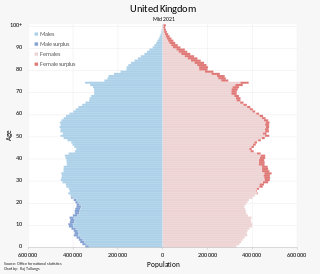
The population of the United Kingdom was estimated at over 67.0 million in 2020. It is the 21st most populated country in the world and has a population density of 270 people per square kilometre, with England having significantly greater density than Wales, Scotland, and Northern Ireland. Almost a third of the population lives in south east England, which is predominantly urban and suburban, with about 9 million in the capital city, London, whose population density is just over 5,200 per square kilometre.

Demographics of Wales include the numbers in population, place of birth, age, ethnicity, religion, and number of marriages in Wales.

The demography of England has since 1801 been measured by the decennial national census, and is marked by centuries of population growth and urbanization. Due to the lack of authoritative contemporary sources, estimates of the population of England for dates prior to the first census in 1801 vary considerably. The population of England at the 2021 census was about 56,489,800.
A nationwide census, known as Census 2001, was conducted in the United Kingdom on Sunday, 29 April 2001. This was the 20th UK census and recorded a resident population of 58,789,194.

The demography of London is analysed by the Office for National Statistics and data is produced for each of the Greater London wards, the City of London and the 32 London boroughs, the Inner London and Outer London statistical sub-regions, each of the Parliamentary constituencies in London, and for all of Greater London as a whole. Additionally, data is produced for the Greater London Urban Area. Statistical information is produced about the size and geographical breakdown of the population, the number of people entering and leaving country and the number of people in each demographic subgroup. The total population of London as of 2021 is 8,799,800.
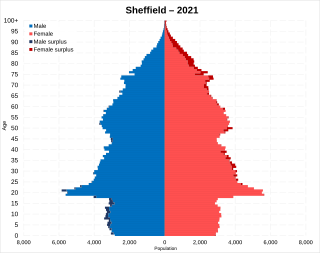
The latest (2021) population estimate for the City of Sheffield is 554,401 residents. This represents an increase of about 17,000 people since the last census in 2011.
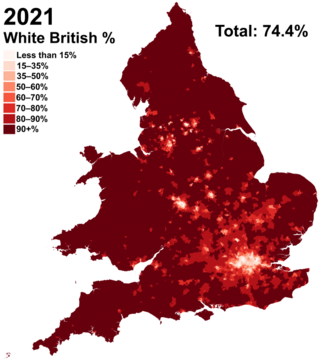
White British is an ethnicity classification used for the native white population identifying as English, Scottish, Welsh, Cornish, Northern Irish, or British in the United Kingdom Census. In the 2011 census, the White British population was 49,997,686, 81.5% of Great Britain's total population. For the United Kingdom entirely, due to different reporting measures within Northern Ireland which includes all those who identified as British with those who identified as Irish, an amalgamated total of 52,320,080 including those who identified as White Irish in Great Britain is given making up 82.8% of the population.
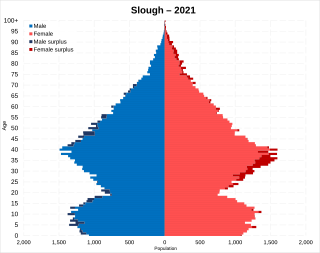
This article is intended to give an overview of the demography of Slough. In 2016, Slough had a population of 149,000 people.

The demography of Birmingham, England, is analysed by the Office for National Statistics and data produced for each of the wards that make up the city, and the overall city itself, which is the largest city proper in England as well as the core of the third most populous urban area, the West Midlands conurbation.
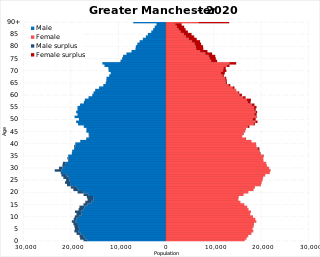
The demography of Greater Manchester is analysed by the Office for National Statistics and data is produced for each of its ten metropolitan boroughs, each of the Greater Manchester electoral wards, the NUTS3 statistical sub-regions, each of the Parliamentary constituencies in Greater Manchester, the 15 civil parishes in Greater Manchester, and for all of Greater Manchester as a whole; the latter of which had a population of 2,682,500 at the 2011 UK census. Additionally, data is produced for the Greater Manchester Urban Area. Statistical information is produced about the size and geographical breakdown of the population, the number of people entering and leaving country and the number of people in each demographic subgroup.

White Irish is an ethnicity classification used in the 2011 United Kingdom Census. In the 2011 census, the White Irish population was 585,177 or 1% of Great Britain's total population.
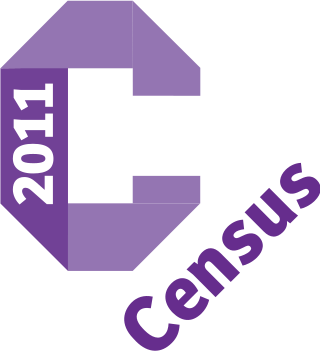
A census of the population of the United Kingdom is taken every ten years. The 2011 census was held in all counties of the UK on 27 March 2011. It was the first UK census which could be completed online via the Internet. The Office for National Statistics (ONS) is responsible for the census in England and Wales, the General Register Office for Scotland (GROS) is responsible for the census in Scotland, and the Northern Ireland Statistics and Research Agency (NISRA) is responsible for the census in Northern Ireland.

Leicester, England is an ethnically and culturally diverse city. It is the thirteenth most populous city in the United Kingdom.

Nottingham, England is an ethnically and culturally diverse city. It is the sixteenth most populous city in the United Kingdom.

Luton, Bedfordshire, England is an ethnically and culturally diverse town of 203,201 people. It's primarily urban, with a population density of 4,696/km2 (12,160/sq mi). Luton has seen several waves of immigration. In the early part of the 20th century, there was internal migration of Irish and Scottish people to the town. These were followed by Afro-Caribbean and Asian immigrants. More recently immigrants from other European Union countries have made Luton their home. As a result of this Luton has a diverse ethnic mix, with a significant population of Asian descent, mainly Pakistani 29,353 (14.4%) and Bangladeshi 13,606 (6.7%).

Bradford, England is an ethnically and culturally diverse city. The City of Bradford metropolitan borough is the sixth most populous local authority district in the United Kingdom, and includes not only Bradford but also the towns and villages of Keighley, Shipley, Bingley, Ilkley, Haworth, Silsden, Queensbury, Thornton and Denholme.

Leeds, England is the third most populous city in the United Kingdom.
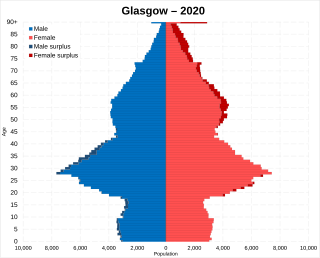
Glasgow is the most populous city in Scotland and the fourth most populous city in the United Kingdom.

Bristol, England is the tenth most populous city in the United Kingdom.
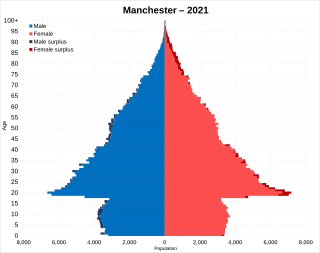
Manchester is a populous city in the North West of England. Its total population as of 2021 is 551,938.